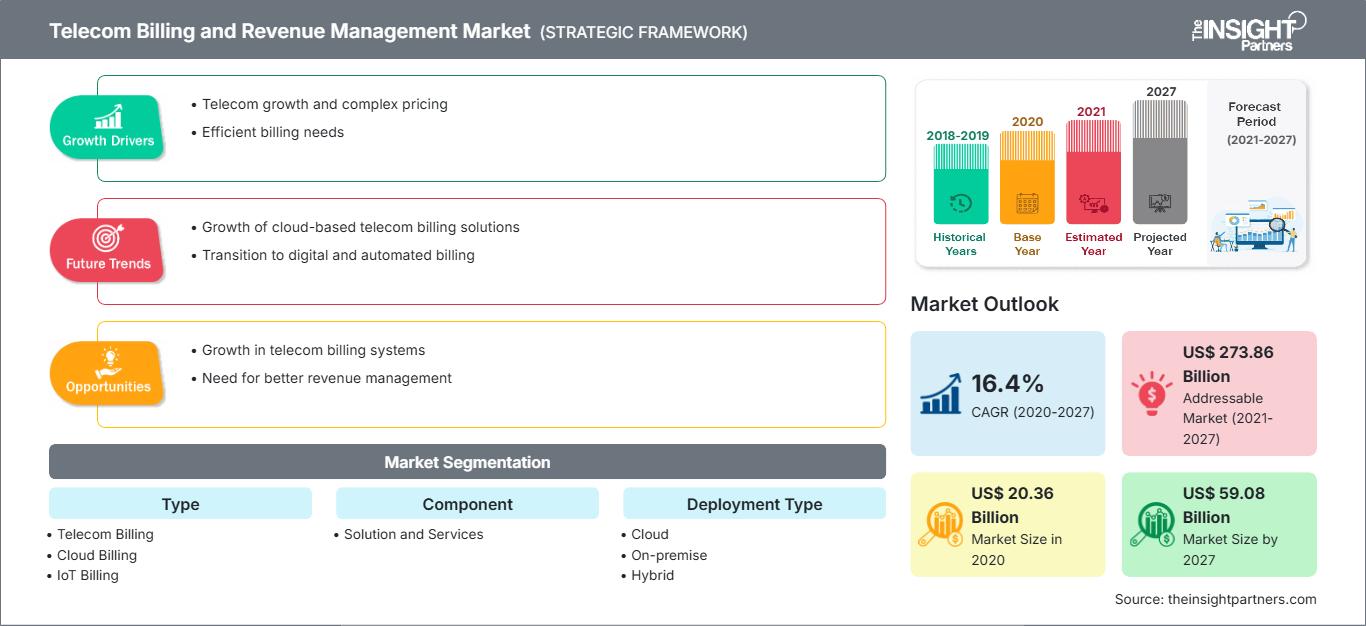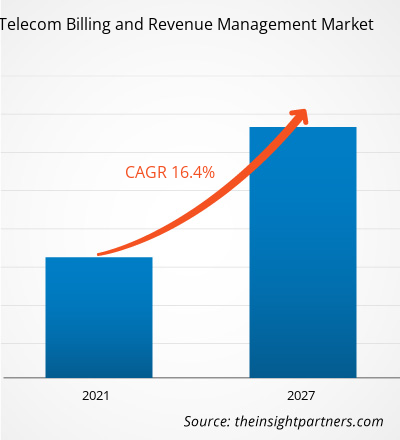Si prevede che il mercato della fatturazione e della gestione dei ricavi nel settore delle telecomunicazioni crescerà da 20.362,5 milioni di dollari nel 2020 a 59.075,4 milioni di dollari entro il 2027; si stima una crescita a un CAGR del 16,4% dal 2020 al 2027.
La crescita del mercato è dovuta anche alla crescente domanda di soluzioni e servizi innovativi per la fatturazione e la gestione dei ricavi. La costante esigenza di fornire servizi di comunicazione avanzati ed esperienze cliente di qualità elevata sta spingendo i fornitori di soluzioni e servizi di fatturazione e gestione dei ricavi nel settore delle telecomunicazioni a sviluppare ulteriormente tali soluzioni e servizi, che siano compatibili e all'altezza per soddisfare appieno le esigenze e la domanda dinamiche degli utenti finali con maggiore scalabilità, flessibilità e funzionalità. Soluzioni di fatturazione e gestione dei ricavi efficienti e flessibili aiutano i CSP a monetizzare ulteriormente l'utilizzo dei dati e dei servizi, fornendo alle aziende migliori capacità di analisi dei dati in tempo reale ed efficienza per canalizzare i flussi di fatturato attraverso soluzioni personalizzate. Aiuta inoltre i CSP a gestire in modo efficiente i crescenti processi di fatturazione e addebito degli abbonati attraverso un'unica piattaforma efficace.
Inoltre, aiuta le aziende e offre loro la sicurezza di lanciare nuove offerte personalizzate, servizi di generazione di fatturato e politiche di addebito in tempi brevi con maggiore efficienza, nonché di monetizzare i propri investimenti infrastrutturali, migliorando al contempo la gestione dei clienti e dei ricavi. I CSP aggiornano continuamente i propri sistemi legacy aggiungendo piattaforme che li aiuteranno a servire una base di abbonati più ampia e migrando verso soluzioni e servizi basati su cloud come SaaS, che li aiuteranno a ridurre il CAPEX ottimizzando al contempo l'OPEX. Inoltre, l'aumento delle tendenze di spesa e dei requisiti per soluzioni come BSS/OSS sta accelerando anche la crescita del competitivo mercato globale della fatturazione e della gestione dei ricavi delle telecomunicazioni.
Impatto della pandemia di COVID-19 sul mercato della fatturazione e della gestione dei ricavi delle telecomunicazioni
La crisi del COVID-19 ha avuto un impatto positivo sulla crescita di alcuni settori come l'IT e le telecomunicazioni. In particolare, la domanda di servizi digitali è cresciuta a un ritmo sostenuto negli ultimi mesi. Tuttavia, si prevede che il calo di attività commerciali, come le partnership per aumentare l'adozione di soluzioni di fatturazione e gestione dei ricavi per le telecomunicazioni in diversi paesi, avrà un impatto negativo sulla crescita espansiva dei fornitori di servizi di fatturazione e gestione dei ricavi per le telecomunicazioni. Pertanto, si verificherà un impatto misto, con un leggero calo della crescita nel 2020 e nel 2021.
Personalizza questo rapporto in base alle tue esigenze
Potrai personalizzare gratuitamente qualsiasi rapporto, comprese parti di questo rapporto, o analisi a livello di paese, pacchetto dati Excel, oltre a usufruire di grandi offerte e sconti per start-up e università
Mercato della fatturazione e della gestione dei ricavi delle telecomunicazioni: Approfondimenti strategici

-
Ottieni le principali tendenze chiave del mercato di questo rapporto.Questo campione GRATUITO includerà l'analisi dei dati, che vanno dalle tendenze di mercato alle stime e alle previsioni.
Gli operatori di telecomunicazioni e i CSP di tutto il mondo si trovano ad affrontare difficoltà nella gestione dei sistemi, nella scalabilità dell'infrastruttura di rete e nella soddisfazione di una base di clienti in continua crescita. Raggiungere un'elevata efficienza operativa, insieme a una migliore gestione e riscossione dei ricavi, è una delle principali priorità e requisiti per gli operatori di telecomunicazioni e i CSP. Soluzioni di fatturazione efficienti basate su cloud offrono agli operatori di telecomunicazioni e ai CSP la possibilità di monitorare efficacemente l'utilizzo dei servizi degli abbonati in base ai piani tariffari e di addebitare di conseguenza. Aiutano i CSP a gestire i pagamenti e i conti e a costruire, pianificare e ottimizzare le reti, supportando al contempo le aziende nella gestione di un elevato numero di transazioni simultanee e richieste dei clienti.
Uno dei maggiori vantaggi che soluzioni e servizi basati su cloud, come il SaaS, offrono agli operatori di telecomunicazioni e ai CSP è il basso investimento iniziale o costo di capitale. Aiuta le aziende a ridurre gli investimenti infrastrutturali e gli sforzi di integrazione, offrendo loro funzionalità come il modello pay-as-you-go, che aiuta anche le aziende a sperimentare nuove soluzioni a basso rischio. Inoltre, modelli di servizi come il SaaS offrono agli operatori di telecomunicazioni e ai CSP la possibilità di implementare e supportare rapidamente servizi nuovi ed esistenti, aiutando così le aziende ad accedere a nuovi mercati in modo più rapido, economico e con maggiore flessibilità.
Approfondimenti basati sui componenti
In base ai componenti, il mercato della fatturazione e della gestione dei ricavi delle telecomunicazioni è segmentato in soluzioni e servizi. I segmenti delle soluzioni hanno detenuto la quota di mercato maggiore nel 2019.
Gli operatori che operano nel mercato della fatturazione e della gestione dei ricavi delle telecomunicazioni si concentrano principalmente sullo sviluppo di prodotti avanzati ed efficienti.
- Nel 2020, TDC, un operatore con sede in Danimarca, ha scelto Comarch SA per offrire le sue soluzioni BSS. L'azienda ha offerto a TDC la sua gestione degli ordini dei clienti, il sistema di fatturazione convergente e il framework di integrazione delle applicazioni.
- Nel 2020, Telecom Fiji Limited, fornitore di servizi di telefonia, ha collaborato con Oracle Communications per aggiornare il coinvolgimento dei clienti e accelerare la fornitura di prodotti e servizi. L'azienda implementerà la gestione della fatturazione e dei ricavi di Oracle come parte della suite Oracle Digital Experience for Communications, per consentire un'esperienza cliente digitale.
Il mercato della fatturazione e della gestione dei ricavi delle telecomunicazioni è stato segmentato come segue:
Mercato della fatturazione e della gestione dei ricavi delle telecomunicazioni - per componente
- Soluzione
- Gestione della fatturazione
- Gestione degli account
- Altro
- Servizi
- Servizi professionali
- Servizi gestiti
Mercato della fatturazione e della gestione dei ricavi delle telecomunicazioni - per componente per tipo
- Fatturazione delle telecomunicazioni
- Fatturazione cloud
- Fatturazione IoT
Mercato della fatturazione e della gestione dei ricavi delle telecomunicazioni - per tipo di distribuzione
- In sede
- Basato su cloud
- Ibrido
Mercato della fatturazione e della gestione dei ricavi delle telecomunicazioni - per area geografica
-
America settentrionale
- Stati Uniti
- Canada
- Messico
-
Europa
- Francia
- Germania
- Italia
- Spagna
- Regno Unito
- Resto d'Europa
-
Asia Pacifico (APAC)
- Giappone
- Cina
- Australia
- India
- Resto dell'APAC
-
Medio Oriente e Africa (MEA)
- Emirati Arabi Uniti
- Dubai
- Arabia Saudita
- Qatar
- Sud Africa
- Etiopia
- Ruanda
- Kenya
- Costa d'Avorio
- Ghana
- Nigeria
- Egitto
- Marocco
- Tunisia
- Turchia
- Resto del MEA
-
Sud America (SAM)
- Brasile
- Argentina
- Cile
- Perù
- Colombia
- Resto del SAM
Approfondimenti regionali sul mercato della fatturazione e della gestione dei ricavi delle telecomunicazioni
Le tendenze e i fattori regionali che influenzano il mercato della fatturazione e della gestione dei ricavi delle telecomunicazioni durante il periodo di previsione sono stati ampiamente spiegati dagli analisti di The Insight Partners. Questa sezione illustra anche i segmenti e la geografia del mercato della fatturazione e della gestione dei ricavi delle telecomunicazioni in Nord America, Europa, Asia-Pacifico, Medio Oriente e Africa, America meridionale e centrale.
Ambito del rapporto di mercato sulla fatturazione e la gestione dei ricavi delle telecomunicazioni
| Attributo del rapporto | Dettagli |
|---|---|
| Dimensioni del mercato in 2020 | US$ 20.36 Billion |
| Dimensioni del mercato per 2027 | US$ 59.08 Billion |
| CAGR globale (2020 - 2027) | 16.4% |
| Dati storici | 2018-2019 |
| Periodo di previsione | 2021-2027 |
| Segmenti coperti |
By Tipo
|
| Regioni e paesi coperti |
Nord America
|
| Leader di mercato e profili aziendali chiave |
|
Densità degli operatori del mercato della fatturazione e della gestione dei ricavi delle telecomunicazioni: comprendere il suo impatto sulle dinamiche aziendali
Il mercato della fatturazione e della gestione dei ricavi nel settore delle telecomunicazioni è in rapida crescita, trainato dalla crescente domanda degli utenti finali, dovuta a fattori quali l'evoluzione delle preferenze dei consumatori, i progressi tecnologici e una maggiore consapevolezza dei vantaggi del prodotto. Con l'aumento della domanda, le aziende stanno ampliando la propria offerta, innovando per soddisfare le esigenze dei consumatori e sfruttando le tendenze emergenti, alimentando ulteriormente la crescita del mercato.

- Ottieni il Mercato della fatturazione e della gestione dei ricavi delle telecomunicazioni Panoramica dei principali attori chiave
Mercato della fatturazione e della gestione dei ricavi delle telecomunicazioni: Profili aziendali
- Accenture PLC
- Alcatel-Lucent SA
- Amdocs, Inc.
- Cerillion PLC
- CSG Systems International, Inc.
- Ericsson
- goTransverse International, Inc.
- Hewlett-Packard Development Company LP
- Huawei Technologies Co., Ltd.
- NEC Corporation
- Oracle Corporation
- Redknee, Inc.
- SAP SE
- XURA
- Panamax
- stl.tech
- Comviva
- Enghouse Networks
- Fiserv, Inc.
- Vcare Corporation
- Mphasis
- Agility CSI
- ESKADENIA
- Netcracker
- Analisi storica (2 anni), anno base, previsione (7 anni) con CAGR
- Analisi PEST e SWOT
- Valore/volume delle dimensioni del mercato - Globale, Regionale, Nazionale
- Industria e panorama competitivo
- Set di dati Excel
Report recenti
Rapporti correlati
Testimonianze
Motivo dell'acquisto
- Processo decisionale informato
- Comprensione delle dinamiche di mercato
- Analisi competitiva
- Analisi dei clienti
- Previsioni di mercato
- Mitigazione del rischio
- Pianificazione strategica
- Giustificazione degli investimenti
- Identificazione dei mercati emergenti
- Miglioramento delle strategie di marketing
- Aumento dell'efficienza operativa
- Allineamento alle tendenze normative






















 Ottieni un campione gratuito per - Mercato della fatturazione e della gestione dei ricavi delle telecomunicazioni
Ottieni un campione gratuito per - Mercato della fatturazione e della gestione dei ricavi delle telecomunicazioni